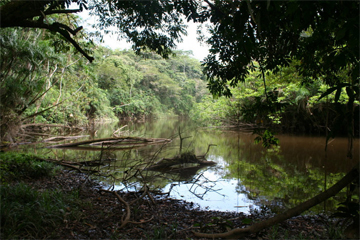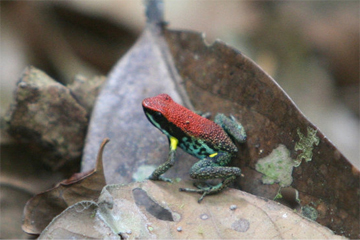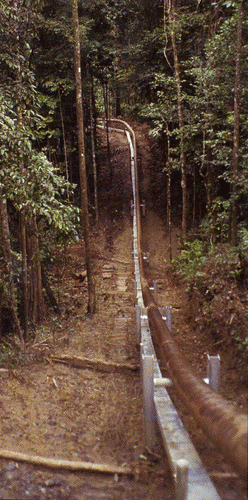September 13, 2010
An Analysis of the Historic Yasuní Fund Agreement between Ecuador and the UNDP
Ecuador’s pioneering initiative to voluntarily leave nearly a billion barrels of oil under Yasuní National Park, an Amazonian reserve that is arguably the most biodiverse spot on Earth, took a major step forward in early August when the government signed an accord with the United Nations Development Programme (UNDP) for the long-awaited establishment of a trust fund. The signing event generated a wave of international media attention, but there has been very little scrutiny of what was actually signed. Here we present an initial analysis of the signed agreement, along with a brief discussion of some of the potential caveats. Due to the precedent-setting nature of this agreement, attention to the details is now of the utmost importance.
The signing event
 Yasuni National Park. Photo by Jeremy Hance. |
The Fund
The Ecuador Yasuní ITT Trust Fund, or Yasuní Fund for short, was established for receipt of contributions to the governmental initiative of keeping at least 846 million barrels of oil permanently under the ITT block within Yasuní National Park. The fund will be administered by the Multi-Donor Trust Fund Office (MDTF Office) of the UNDP. The Fund commenced with the signing of the MOA and is now officially open for receipt of contributions.
Contributions to the Yasuní Fund will be accepted from three main sources: 1) contributions from Governments, Intergovernmental Entities, Non-Governmental Organizations, Private Foundations, Private-Sector Organizations, and individuals; 2) contributions from the public at large, and 3) income from the sale of certificates (see below) by the Government to private and public entities in return for mitigating greenhouse gas emissions through avoidance of oil and gas extractions from the Yasuní area. The trust fund notes that the former option only applies if, in the future, the world carbon market accepts the certificates as equivalents of Emission Permits.
- Caveat #1. This third funding source, if enacted, would surely become quite controversial and problematic. Whereas the first two funding sources are contributions, the third source represents an entry into the world of carbon credits trading. Shifting away from straight contributions towards an emission trading scheme jeopardizes any climate change contribution the initiative claims to make because a polluter will be allowed to emit an equivalent amount of CO2 in another part of the world.
 Poison dart frog in Yasuni National Park. Photo by Jeremy Hance. |
The Spending Plan
The Yasuní Fund will have two windows: a Capital Fund Window and a Revenue Fund Window. The Capital Fund Window will be financed by contributions and/or the sale of certificates, whereas the Revenue Fund Window shall be replenished with mandatory annual revenue payments received for the use of the funds from the Capital Fund Window. Funds from the former will be used to finance renewable energy projects, while the latter will be used to fund conservation and reforestation projects, social programs, energy efficiency, and research and innovation initiatives. Interestingly, only national institutions of Ecuador may submit proposals for the renewable energy projects, so the traditional “economic hitman” style of just funneling money back to foreign corporations will be avoided, but the committee should consider fruitful collaboration with countries and organizations that have expertise in this area.
- Caveat #2. Hydroelectric projects are included in the list of renewable energy projects to be funded by the capital. Although we support increased funding for renewable sources such as solar, wind, and geothermal, many proposed hydroelectric projects in Ecuador may be quite damaging to the environment and actually increase CO2 emissions. Therefore, we recommend some sort of review process that assures funding won’t go to controversial hydroelectric projects that require road-building through primary forest or large reservoirs that drown primary forest, both of which cause emission of greenhouse gases and may reduce or even negate any climate reductions boasted by the initiative.
Caveat #3. Any funding towards conservation and social programs and energy efficiency may not come for many, many years. If we understand the language correctly, a renewable energy project must get up and running from the funding obtained from the Capital Fund Window, and then make a profit, before any money goes toward any of the initiatives listed under the Revenue Fund Window.
 Oil Pipeline in the Rainforest of Ecuador. |
The Steering Committee will consist of six full members, each one with a vote: three representatives of the Ecuadorian Government, including the Chairperson; two representatives from the Contributor Governments; and one Ecuadorian civil society representative. The Steering Committee shall make decisions by majority, aiming to consensus, but the Chairperson will have the casting vote in the case of no consensus.
Thus, the Ecuadorian government has substantial control over the process of proposal selection and final funding decisions. Who determines how the funds will be spent was the main point of contention back in January when President Correa very publicly rejected any infringements on the sovereignty of Ecuador in making these decisions. The agreed arrangement, therefore, clearly reflects Correa’s strong stance on this issue. There will most likely be substantial pressure on the civil society representative of the Steering Committee to ensure that concerns of indigenous and local communities are being addressed.
The Initial Goal
The contributions to the Yasuní Fund must reach a minimum threshold of US$ 100 million by the end of 2011 to initiate spending of the capital. The full expected minimum amount is US$ 3.6 billion over 13 years. In the case that the Yasuní Fund does not receive US$ 100 million by December 2011, Ecuador will refund the contributors and President Correa will surely move toward developing the oil fields.
The Default Mechanism
In the event that the Ecuadorian Government defaults on its commitment and decides to initiate oil prospecting in the Yasuní ITT oil fields, the CGYs will entitle the holders to be reimbursed the equivalent to the face value of the CGYs. In that event, the agreement states that the uncommitted balance of the Capital Fund Window shall be used by the Government towards the reimbursement to the Contributors of the face value of the CGYs.
- Caveat #4. It is not clear what happens to the money that was already spent from the Capital Fund Window. To really act as a deterrent to future administrations that may be tempted to drill, the agreement must make clear that even spent funds must be returned.
There is clearly an added emphasis on the climate change component of the initiative. For example, the CGYs will include the metric tons of CO2 avoided thanks to that particular contribution. And the maximum total amount of CGYs issued by Ecuador will be equivalent to the value of a total of 407 million metric tons of CO2 not emitted as a result of not exploiting the 846 million barrels of oil. The UNDP describes Ecuador as “the first developing country to propose an effective, quantifiable and verifiable carbon abatement model.” In this sense, the Ecuadorian proposal moves beyond REDD and avoided emissions from deforestation, and focuses more on avoided emissions from eventual fossil fuel burning, a simple yet potentially revolutionary concept. Indeed, President Correa has announced that Ecuador will be highlighting the Yasuni-ITT Initiative at the upcoming climate change meetings in Cancun, Mexico.
- Caveat #5. This initiative will only effectively reduce global CO2 emissions if a number of strict conditions are met. First, as mentioned above, there can be no emissions trading in exchange for certificates and no funding of high-impact hydroelectric projects. Second, the issue of leakage (i.e. simply moving oil extraction to another locale) must be addressed. The Correa administration continues to discuss the possibility of drilling for oil in the area adjacent to ITT known as Block 31, and has announced that in April 2011 they will attempt to lease at least 10 new oil concessions located in the remote southeastern Ecuadorian Amazon. Similarly, the Canadian company Ivanhoe is quickly moving towards development of the Pungarayacu oil field in eastern Ecuador, which may contain even more oil than ITT. So in a brewing nightmare scenario, while on one hand Ecuador makes strides with the Yasuní-ITT Initiative next year, they will be opening up entirely new areas to development, essentially canceling out any climate gains. Third, the initiative must be replicated in other mega-diverse countries with similar hydrocarbon conflicts so the total avoided emissions reach a considerable level. The 407 million metric tons associated with the ITT oil fields are reportedly equivalent to the annual emissions of France or Brazil. If this figure can be multiplied several times over in countries such as Guatemala, Peru, Bolivia, and Nigeria, than we just may indeed be talking about an important global contribution.
In conclusion, we find that the historic trust fund agreement between Ecuador and the UNDP represents a major advancement as an innovative and potentially precedent-setting tropical forest conservation mechanism. It provides, for the first time, the structure and details regarding the implementation of the revolutionary concept of a developing country being compensated for leaving fossil fuels in the ground in perpetuity. However, it is not yet perfect, and numerous caveats remain, particularly in regards to this type of initiative being billed as a tool to combat climate change. As we understand it, the Steering Committee will have the ability to change certain aspects of the fund. Therefore, we hope that the terms of the arrangement continue to be improved based on comments from direct actors and the general public, such as those detailed above. Meanwhile, the initiative has finally entered the moment of truth for potential funders, as we await news of confirmed contributions from the international community.


No comments:
Post a Comment